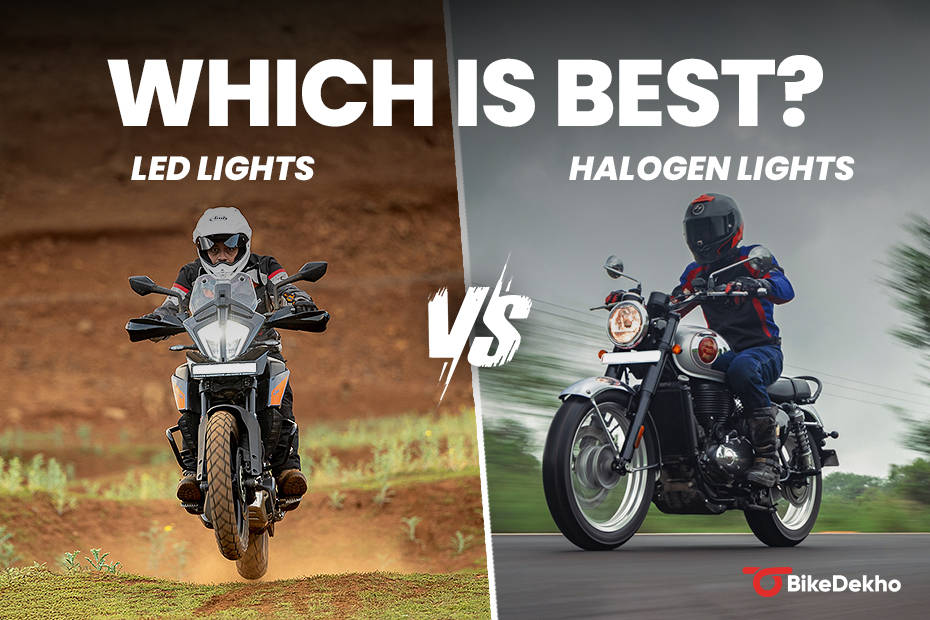Halogen Lights vs LED Lights, Which Works Best on Two-wheelers?
Published On Nov 3, 2024 11:00 AM By Team Bikedekho
- 5887 Views
Let’s have a look at which is the better of the two once and for all

Lighting is one of the most critical aspects of two-wheeler riding. Unlike four-wheelers, which come equipped with several factory-installed lighting solutions and ample space for multiple bulbs, two-wheelers face unique challenges. Halogen lights have long been the standard because they offer a warm, steady beam of light that has served us riders well for decades. These lights are cost-effective, easy to replace, and provide adequate illumination for most riding conditions. That being said, they do have their flaws, such as higher energy consumption (they are less powerful than LEDs for the same power input) and a relatively shorter lifespan.
On the other hand, LEDs are the more modern alternative to halogen lights. They have become the norm for manufacturers these days, and most current motorcycles and scooters that you see today come equipped with LEDs. They are known for their exceptional brightness, energy efficiency, and durability. LEDs offer a brighter beam that provides good visibility. If you are someone who finds themselves doing a lot of riding in low-visibility or night-time conditions, LEDs can prove useful. They are also often equipped with advanced features like adaptive lighting, which adjusts the beam based on speed, tilt, and surrounding light conditions, and this further improves your safety. While halogen bulbs were seen on every kind of two-wheeler in the past, today they’re seen as a more affordable component, while LED lighting is said to be the premium option of the lot. You will however find that some classic motorcycles retain halogen lighting for a vintage appearance. Let’s look at these options in greater detail.
A Short Science Lesson
Halogen bulbs use heated tungsten filaments surrounded by halogen gas to produce visible light. Halogens connect directly to the battery, drawing consistent power with a simple setup. LEDs rely on electrical current passing through semiconductor materials to emit light.
Advantages of Halogen Lights:
-
People are familiar with halogen bulbs as they produce warmer colour temperatures (more yellow) and have been standard for many years.
-
They create a better spread of light
-
Halogens excel in foggy or dusty conditions due to their warm light penetrating fog and dust better than LED’s cooler colour temperature (more blue light).
-
They are cheaper compared to LED counterparts (useful when it comes to replacing them)

The BSA Goldstar comes with Halogen lights, to know more about the bike click here.
Disadvantages of Halogen Lights:
High power consumption as they produce more heat.
Relatively shorter lifespan compared to LEDs, requiring more replacements.

Advantages of LED Lights:
-
Highly energy efficient as they reduce overall power draw and extend battery life
-
Extremely long lifespans eliminate the need for frequent replacements or maintenance
-
Their compact size facilitates sleek designs without compromising illumination quality
-
LED headlights offer brighter, whiter light for improved visibility during night time riding, provided the air is clear of dust or fog
-
Upon activation, LED headlights reach maximum brightness almost instantly

KTM 390 Duke gets an awesome looking LED headlight, check out our road test review here.
Disadvantages of LED Lights:
-
Cooler colour temperatures might reduce visual comfort or dazzle the eyes in certain scenarios, such as foggy or snowy conditions. This is also a concern as these bright lights can dazzle oncoming rider/drivers and hamper how much they can see
-
Limited compatibility issues with older two-wheelers or those with non-standard wiring configurations
-
Higher cost
Is LED Really a Better Choice than a Halogen?
While halogens are large, bulky and heavy energy consumers, LEDs are more energy efficient, are brighter, and have better longevity. Halogens may be the way to go for those who value affordability and simplicity. But LEDs are hard to beat for riders seeking superior visibility, energy savings, and long-term reliability.

The TVS Apache RTR 310 gets adaptive headlights! Click here to know more.
Test Ride Before Decision Making:
Nothing informs your choice better than test-riding bikes with these different lighting systems. During a test ride, make sure you switch between both, high and low light beams to understand the throw of light and if the need for aftermarket lights is necessary. And, if applicable, the performance of adaptive lighting features that adjust automatically based on speed, tilt, or surrounding light conditions. Another critical aspect to monitor is whether the headlamp causes eye strain. Prolonged exposure to inadequate lighting can lead to discomfort or fatigue, which may affect your long-term riding comfort and overall alertness. Firsthand experience with different headlamp systems is crucial for making an informed decision. Pay attention to functionality, comfort, and adaptability during your test rides to ensure you choose a headlamp system that meets your needs and enhances your riding experience.

Wrapping Things Up
To summarise, if you prioritise great visibility for Indian conditions while keeping costs and ease of replacements in check, halogen lamps are the best solution to have for primary and auxiliary lamps for any kind of motorcycle. They provide a warm, steady beam, making them reliable for your everyday commutes and as auxiliary lamps for highway touring. However, they consume more energy and have a shorter lifespan compared to LEDs. On the other hand, if you are looking for energy efficiency and longevity, LEDs are for you.
However, since they are cooler in terms of light temperature, they do not become great companions for touring needs. One big concern, especially in India, is that given our forever dusty conditions, LEDs can be less effective. Because the cooler colour temperature of LED lights tend to scatter way more because of dust. Halogens offer better penetration through dusty conditions.
So make your choice wisely!
